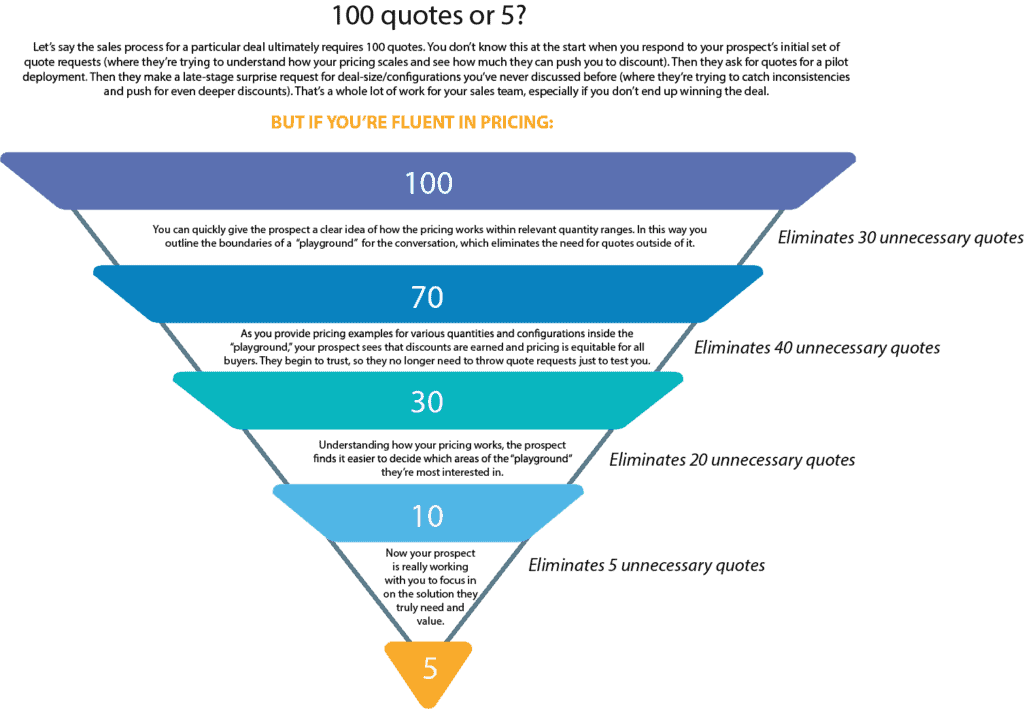Is your sales team fluent in software pricing?
Two of my favorite stories, told to me by sales execs, demonstrate how the ability to fluently present, explore and defend software pricing on the fly affects sales closings and outcomes. I’ve summarized them in the sidebar. The first is about a surprise performance required of RFP short-listers. The second recounts a conversation with a CIO. In both cases, the salesperson was put on the spot to explain pricing. One result was win-win; the other, lose-lose.
Could you explain your pricing rationale in 10 minutes while eating a sandwich?
This sales team did. They were competing in an RFP process and had been invited, along with other short-list candidates, to a morning of seller presentations. Two minutes before lunchtime, the buyer announced they would be breaking into working lunch groups, during which sellers would have to explain the rationale behind their pricing. Only one team was able to do it. Between bites, they explained simply and quickly how the pricing model worked and scaled. Fluidly they moved between price point discount dollars, discount percentages and various possible deal configurations. Answering questions and serving up improvised relevant examples, they demonstrated how discounts could be earned through volume, and that pricing was fair and uniform for all buyers.
OUTCOME: Seller won the $4.5M ARR deal; buyer won by choosing a trusted provider, knowing the solution would scale and being able to accurately forecast current and future costs.
“What is it going to take to get this deal done?!”
A salesperson was on a call with the CIO of a company considering moving from the provider’s on-premises software to its new cloud-based solution. This customer was open to migration, but also considering a competitive solution. The CIO asked for the call because he was struggling to compare perpetual and subscription pricing. The salesperson erroneously centered his argument on the price per unit of cloud pricing vs. price per unit of on-prem annual maintenance. CIO’s response: “I’m just not seeing the added value.” Unable to clearly explain the differential value, the frustrated salesperson defaulted to discounting, asking, “What is it going to take to get this deal done?!” To which the CIO replied, “Hell if I know,” cutting off contact and going with the competitor in disgust. If the salesperson had been fluent in pricing, he could have educated the CIO on why the cloud pricing was actually cheaper than the on-prem software.
OUTCOME: Seller lost deal; buyer lost by choosing an alternative solution that didn’t fit needs as well.
What is software pricing fluency?
Everyone in sales is familiar with the concept of situational fluency. It’s the ability to quickly understand what the buyer is telling you about their needs and what they value. Fluent salespeople respond with agility when faced with new information or situational changes. They quickly reset and present the right offers and information to move the sales process along toward closure.
Pricing fluency is a less-known concept, focused on the economics of the deal. It’s the ability to quickly and clearly explain the rationale behind your pricing model, show how it scales, and defend its integrity under questioning. Salespeople fluent in pricing have the confidence to tour prospects through how pricing works. They have the agility to come up with relevant examples and accurately answer “what if?” on the fly.
This quality is rare enough among salespeople that those who have it exercise a definitive advantage.
Think about the sidebar stories. There was no time, in either case, to contact a sales manager or work up new examples based on a discretionary discount or bespoke deal framework. Even if there had been time, the process would have prolonged the sales cycle unnecessarily.
Salespeople fluent in pricing can respond immediately in a manner that builds trust and enables buyers to see how the economics of the deal will play out for them initially and in the future. That accelerates sales cycles. It can also drastically reduce the number of quotes requested (view infographic) and the likelihood buyers will insist on proof of concepts/pilots for risk mitigation. It can encourage buyers to fold an additional related product into an initial purchase. Deal velocity and sales team productivity climb.

How do sales teams achieve software pricing fluency?
To build a sales team armed with pricing fluency, do you need individuals who are super-smart and unusually glib? No more so than the average talented, motivated salesperson. But there are several things software companies must provide to help their sales teams achieve pricing fluency:
- Verifiable commitment to Market Fairness Pricing: Buyers purchasing the same set of products and services pay the same price. In organizations doing a substantial number of discretionary, random and bespoke deals, salespeople are at a loss to present a rationale prospects will understand and perceive as fair. Lacking trust, buyers often take a defensive posture, complicating the process by requesting lots of different quotes. Most of these requests aren’t for configurations the buyer organization is actually interested in. They’re just thrown in to understand how your pricing scales and as part of maneuvering for deeper discounts.
- Clarity around value. It’s amazing to me how many companies under-equip their salesforce to discuss and defend value. Often this problem stems from failure to properly design the full product, which includes value-aligned licensing, targeted packaging and an optimized pricing model. If the full product hasn’t been delineated, salespeople may have trouble clearly explaining how user organizations will derive value from your software and turn it into economic gains. If so, they’re going to have a tough time defending what you want to charge for it.
- Simple, unambiguous optimized pricing model. Optimal pricing models are systematic and programmatic, using data and formulas to remove ambiguity. They reflect how customers gain value from the product, cover edge and corner cases, work for large and small organizations, address a full range of ordering scenarios, and continue to make sense to customers as they expand deployments. A few tips: Pricing should be easy to explain and demonstrate using examples. Try not to create too many variables, which not only make salespeople’s brains explode, but invite gaming and exploitation from buyers. Avoid pricing tiers (a holdover from industrial volume pricing), which can depress revenues and make accurately forecasting them near-impossible. Instead move into continuous discounting, where customers earn more discounts as they spend more—encouraging them to increase upfront commitments.
- Data-driven tools for interactively navigating the topography of price possibilities. Sales teams need tools that enable them to move with agility across purchase volumes and associated discounts based on number of users, consumption (usage) or other licensing metrics. Tools driven by algorithms anchored in optimized pricing models do far more than simple calculations based on SKU assembly and list prices. They enable salespeople to rapidly explore a wide range of deal configurations, quickly calculating at-scale discounted unit prices as well as overall purchase discount percentages. These tools give salespeople confidence to defend net prices. Let’s say a procurement specialist asks to see a random sample of deals with like configurations. No problem, because comparison of these deals will prove your company treats customers uniformly and fairly.
- Pricing fluency practice as part of pre-call prep. Sales preparation normally involves estimating prices for configurations within a probability range for the prospect. For pricing fluency, you also want to be able to explain the rationale behind that pricing. You also want to be prepared for the unexpected, like when the prospect pops a surprise such as, “I know I said we need 100 units, but what would it look like at 10,000 across three divisions?” If salespeople have numbers 1-4 in this list, they can easily answer any unexpected question. A bit of practice helps them realize that they have the answers at their fingertips and builds confidence.
- Continuous pricing improvement. The data-driven pricing tools described in #4 can also be used by sales analysts and management to refine the pricing model, steer the product roadmap and adjust licensing and packaging to changing customer needs and market opportunities. These tools help you simulate the impact of changes and time/track gradual, strategic deployments of new pricing and packaging. They help keep sales teams just ahead of where prospective customers are going.
Stay tuned for more!
Fluency is just one of the powerful advantages of Market Fairness Pricing. Stay tuned for subsequent posts to find out how it works and why it’s so beneficial for both buyers and sellers. Or contact me at chrismele@softwarepricing.com.




